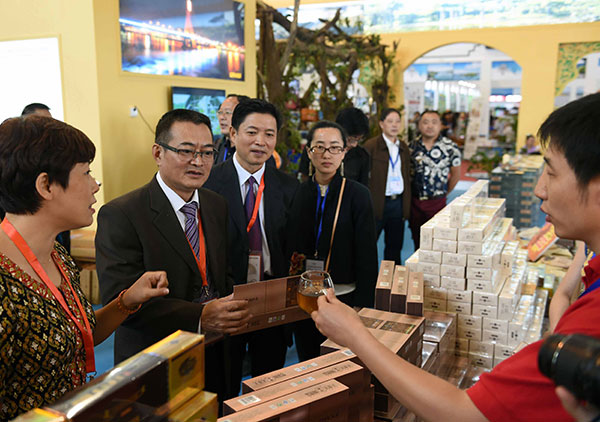|
 |
|
Visitors are tasting tea at the China-South Asia Expo held in Kunming on Friday. [Photo/China Daily] |
Vice-President Li Yuanchao told a major trade event on Friday that the need for closer cooperation between China and its South Asian neighbors has never been greater as the international trade landscape continues to experience what he called "a profound adjustment".
Underlining the country's commitment to deepening trade and economic cooperation with countries and regions in South Asia through the Belt and Road Initiative, Li said Asian nations have to be prepared to use every complimentary geographical and economic advantage available to them to compete effectively.
He made the remarks during the opening ceremony of the third China-South Asia Exposition being held in Kunming, Yunnan province.
The vice-president said that historically weak investment in infrastructure in the region had already created a bottleneck for development in South Asia, and only better connectivity in the future will lead to common prosperity.
He said by carefully using the Silk Road Fund $40 billion investment fund, the construction of a modern-day Silk Road will play a central role in achieving future regional progress.
Liu Jinxin, secretary-general of the Greater Mekong Sub-region Logistics Research Center, said Yunnan's proximity to many important South Asian countries such as Bangladesh, Bhutan, India, the Maldives, Nepal and Sri Lanka means it will prove a crucial geographical link in the initiative.
Liu said that current trade volumes between China and South Asia are relatively small, but there is great potential for growth.
The GMS is an economic area bound together by the Mekong River, comprising Cambodia, Laos, Myanmar, Thailand, Vietnam and Yunnan province.
"Much of the South Asian market has been largely overlooked in the past, but there are so many areas where bilateral trade can be boosted," he said.
"Through the Belt and Road Initiative, business opportunities will be further explored.
"For example, India supplies more than 30 percent of the world's tea, and China also has a huge demand for tea consumption.
"Nearby Pakistan, too, has a huge demand for infrastructure and port construction and China can help share its experience in those areas," he said.
Liu also said he supported the building of a sub-regional financial mechanism to promote the internationalization of the Chinese yuan, which would help the flow of development capital across the region.
"We are promoting the internationalization of the renminbi and cross-border financial cooperation, and South Asia and Southeast Asia will benefit from the process," said Li Lihui, a member of the Financial and Economic Affairs Committee of the National People's Congress.
The Belt and Road Initiative was put forward by President Xi Jinping in 2013, with the purpose of rejuvenating the two ancient trading routes and further opening markets in a mutually beneficial manner.
It refers to the Silk Road Economic Belt, which will link China with Europe through Central and Western Asia, and the 21st Century Maritime Silk Road, which stretches from southern China to Southeast Asia and even to Africa and Europe.
Li Xinyi contributed to this story.
